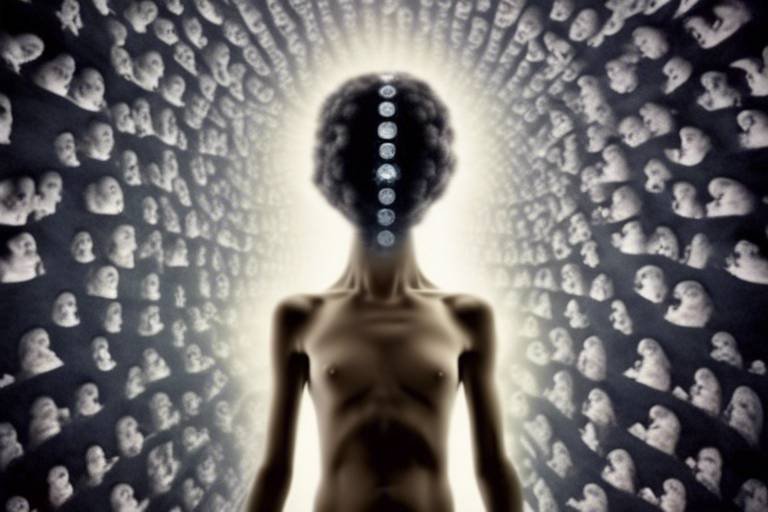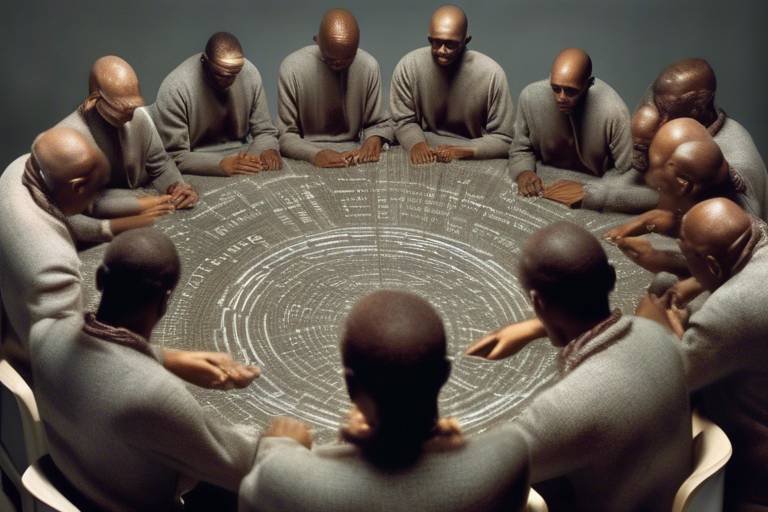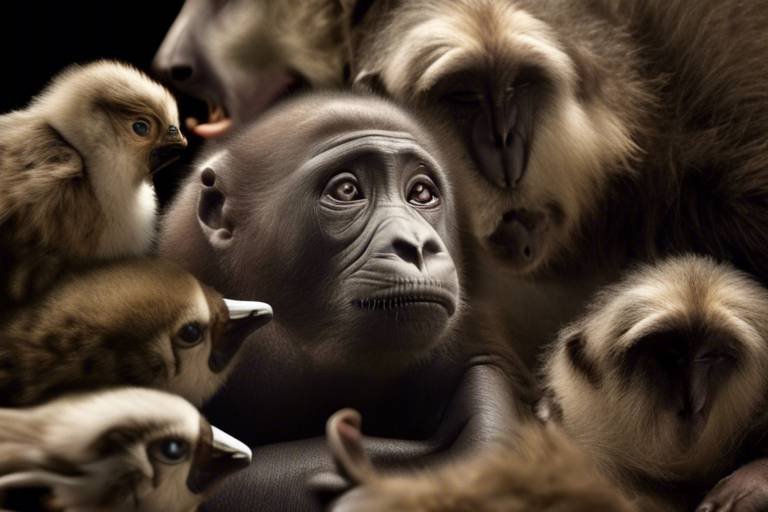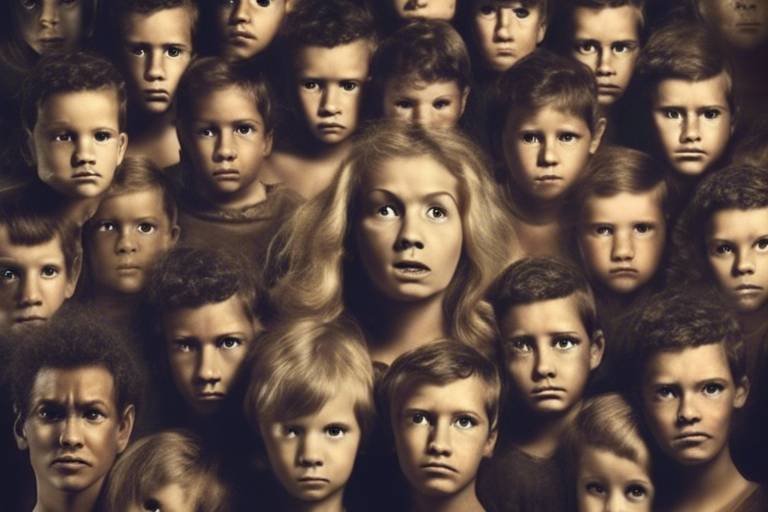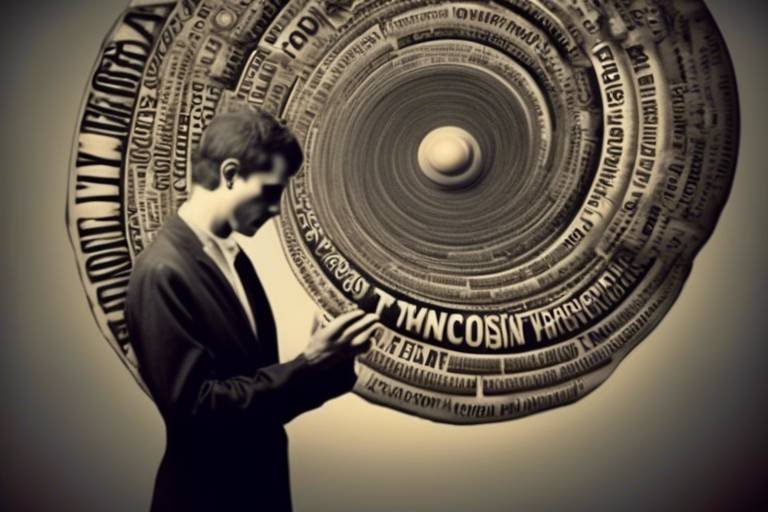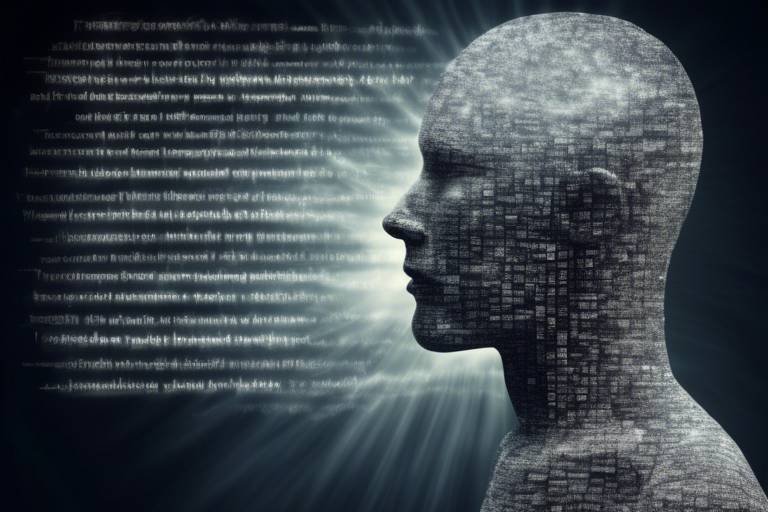The Mystery of Shared Dreams - A Glitch in Consciousness?
Have you ever woken up from a dream and immediately shared it with someone, only to find that they experienced something strikingly similar? This intriguing phenomenon, known as shared dreams, has puzzled both dreamers and scientists alike. The idea that two or more individuals can share a dream experience raises fascinating questions about the nature of consciousness and the connections between people. Are these dreams merely coincidences, or do they suggest a deeper, perhaps even mystical, link between individuals? In this article, we will explore the psychological, scientific, and cultural implications of shared dreams, along with personal anecdotes that highlight their significance.
Shared dreams occur when two or more people report having similar dreams or dream themes. This phenomenon can manifest in various ways, from experiencing identical scenarios to feeling the same emotions during the dream. The characteristics of shared dreaming can vary widely, as some individuals may find themselves in a dream world together, while others might simply dream of the same events occurring separately. These dreams often leave a lasting impact, prompting dreamers to question the nature of reality and their connections with one another.
Psychologists have long been fascinated by shared dreams, delving into the emotional and psychological factors that may contribute to their occurrence. One prominent theory is the concept of the collective unconscious, proposed by Carl Jung, which suggests that individuals share a reservoir of experiences and memories that transcend personal history. This idea implies that shared dreams may be a manifestation of these deeper connections, revealing insights into our emotional lives and relationships.
The strength of emotional bonds between individuals can significantly influence the likelihood of experiencing shared dreams. Close friends, partners, and family members often report a higher frequency of shared dreaming, suggesting that shared experiences and emotional intimacy may play a crucial role in dream synchronization. When we share our lives with others, our subconscious minds may become intertwined, leading to dream experiences that reflect our collective thoughts and feelings.
Real-life case studies provide compelling insights into the phenomenon of shared dreams. For instance, a couple may dream of the same vacation spot or have recurring dreams about a shared fear, such as falling or being chased. These shared experiences not only deepen their emotional connection but also serve as a reminder of their intertwined lives. One notable example involves a group of friends who, during a sleepover, all dreamt of a mysterious figure guiding them through a labyrinth. The impact of such experiences can be profound, often leading to discussions about their meanings and implications.
Therapists have begun to explore the potential of shared dreams in therapeutic settings. By discussing shared dream experiences, clients can gain valuable insights into their emotional states and interpersonal relationships. This exploration can enhance communication, foster understanding, and even facilitate healing. Shared dreams can act as a mirror, reflecting the dynamics of relationships and offering a unique opportunity for growth and connection.
While the phenomenon of shared dreams remains largely unexplained, various scientific theories attempt to shed light on the neurological and psychological mechanisms at play. Some researchers propose that shared dreams may result from neural synchrony, where the brainwaves of individuals become aligned during sleep. This synchronization could potentially lead to overlapping dream experiences. Additionally, the role of mirror neurons is being examined, as these brain cells are known to activate when we observe the actions of others, suggesting a possible link between shared experiences and dream content.
Throughout history, cultures have attributed special meanings to shared dreams. In many societies, these dreams are viewed as significant spiritual experiences or prophetic messages. For example, Indigenous cultures often interpret shared dreams as a sign of strong community bonds or as messages from ancestors. Understanding these cultural interpretations can enrich our perspective on shared dreaming, revealing how deeply intertwined our dreams are with our social and spiritual lives.
Shared dreams have appeared in various myths and folklore, often symbolizing connection or prophecy. Stories of dreamers who experience the same visions have been passed down through generations, highlighting the significance of these shared experiences. For instance, in some Native American traditions, shared dreams are believed to be a means of communication between the living and the spirit world, providing guidance and insight into the future.
In contemporary society, shared dreams are often viewed through both psychological and spiritual lenses. Some people see them as opportunities for personal growth, while others regard them as mystical experiences that transcend the ordinary. The modern interpretation of shared dreams encourages individuals to explore their meanings and implications, fostering a deeper understanding of their relationships and emotional landscapes.
Many individuals have compelling stories about their shared dream experiences. These narratives often reveal the profound impact that such dreams can have on personal relationships and self-awareness. By reflecting on their encounters, readers may find connections to their own lives and consider the meanings behind their dreams.
Some people participate in collective dreaming events, where they intentionally synchronize their dreams with others. These gatherings can be motivated by a desire for deeper connections, shared experiences, or even spiritual exploration. The outcomes of such events can vary, with participants reporting everything from profound insights to unexpected emotional releases.
Shared dreams can significantly strengthen bonds between friends and partners. These experiences often lead to deeper conversations and a greater understanding of each other's thoughts and feelings. As dreamers navigate the complexities of their shared experiences, they may find themselves growing closer and more emotionally attuned to one another.
- What are shared dreams? Shared dreams occur when two or more individuals report having similar dream experiences.
- Can shared dreams be explained scientifically? While largely unexplained, theories suggest possible neurological mechanisms like neural synchrony and mirror neurons.
- How do relationships impact shared dreaming? Emotional bonds and shared experiences can increase the likelihood of shared dreams.
- What cultural significance do shared dreams hold? Many cultures view shared dreams as significant spiritual experiences or prophetic messages.

[Understanding Shared Dreams]
Shared dreams are a fascinating and enigmatic phenomenon that many people have experienced but few truly understand. Imagine this: you drift off to sleep, and in the depths of your slumber, you find yourself in a world that feels eerily familiar. You’re not alone; a friend or loved one is right there with you, experiencing the same vivid scenes, emotions, and narratives. This is the essence of shared dreaming—where two or more individuals report having the same dream or similar dream themes. It's like a cosmic connection that transcends the boundaries of individual consciousness, creating a shared landscape of imagination and emotion.
The concept of shared dreams raises many questions. What causes these dreams to align? Are they merely coincidences, or do they hint at something deeper within our psyches? To understand shared dreams, we first need to define them. They can be categorized into two main types: concurrent dreams, where individuals dream about the same events at the same time, and resonant dreams, where the dreams share similar themes or symbols but may not occur simultaneously. This distinction is crucial because it highlights the different ways in which our minds can intertwine during sleep.
Interestingly, shared dreams often occur among people who have strong emotional connections. Whether it’s a romantic partner, a close friend, or even family members, the bonds we share can heighten the likelihood of experiencing these synchronized dreams. This connection can be likened to a psychic thread that pulls our subconscious minds together, allowing us to share a dream space. However, it’s not just emotional ties that play a role; shared experiences, such as significant life events or trauma, can also create a fertile ground for shared dreaming.
In exploring the characteristics of shared dreams, researchers have noted several common elements. Often, these dreams are rich in detail and emotion, leaving a lasting impression on those who experience them. Participants frequently report feelings of joy, fear, or even enlightenment during these dreams, suggesting that they are not just random occurrences but rather meaningful experiences that can reveal insights about our lives and relationships.
To better understand shared dreams, it’s essential to consider the psychological and cultural frameworks that surround them. For instance, many cultures have their own interpretations of shared dreaming, viewing it as a spiritual or mystical experience. This cultural lens can shape how individuals perceive and value their shared dreams. In the upcoming sections, we will delve deeper into the psychological perspectives and cultural significance of shared dreaming, exploring how these experiences can enrich our understanding of human consciousness.

[Psychological Perspectives]
When we dive into the realm of shared dreams, we uncover a fascinating intersection of psychology and consciousness. Psychologists have long been intrigued by the idea that two or more people can experience similar or even identical dreams. This phenomenon raises numerous questions about the nature of our minds and the connections we share with others. Could it be that our subconscious minds are more intertwined than we realize? Or is there something deeper at play, perhaps a glimpse into a collective unconscious?
One of the most compelling aspects of shared dreaming is the role that emotional connections play in these experiences. When individuals share a close bond—be it familial, romantic, or platonic—they may find themselves dreaming in sync more often than not. This synchronization might be attributed to the emotional energy exchanged during waking hours. Think of it like a musical duet; when both singers harmonize their voices, the result is a beautiful melody that resonates with listeners. Similarly, shared dreams can be seen as a harmonious blend of two minds, echoing each other's thoughts, fears, and desires.
Another psychological theory that sheds light on shared dreams is the concept of the collective unconscious, a term popularized by the Swiss psychiatrist Carl Jung. This theory suggests that all humans share a set of memories, experiences, and archetypes that transcend individual consciousness. In this context, shared dreams could be viewed as a manifestation of these collective elements, where individuals tap into a deeper layer of shared human experience. Imagine it as a vast ocean of thoughts and feelings, where each person's dream is a drop of water contributing to the larger body.
Relationships can significantly influence the likelihood of shared dreams. When two people share significant life experiences, their emotional bonds may create a fertile ground for dream synchronization. For instance, couples who have been together for years often report dreaming about similar themes or scenarios, reflecting their intertwined lives. This phenomenon can also extend to close friends or family members who share a deep emotional connection. The more closely linked we are to someone, the more likely our subconscious minds will resonate with one another during sleep.
Real-life case studies offer fascinating insights into shared dreams. Take, for example, the story of two sisters who, during a particularly stressful period in their lives, began to have recurring dreams about a mysterious forest. Despite living in different cities and leading separate lives, both sisters reported similar details about the dream, including the sights, sounds, and even the emotions they felt while dreaming. This shared experience not only deepened their bond but also provided a unique lens through which they could explore their individual struggles.
Interestingly, therapists have started to recognize the therapeutic potential of shared dreams. In therapy sessions, discussing shared dreams can serve as a powerful tool for enhancing communication and understanding between clients. When individuals openly share their dream experiences, it can lead to deeper revelations about their emotions and relationships. This practice can help clients explore their feelings, fears, and desires in a safe environment, facilitating healing and growth. In essence, shared dreams can act as a bridge that connects individuals to their inner selves and to each other.
As we explore these psychological perspectives, it becomes clear that shared dreams are not merely a curiosity; they hold significant implications for our understanding of human connection and consciousness. They invite us to ponder the mysteries of our minds and the profound ways in which we relate to one another.
- What are shared dreams? Shared dreams occur when two or more individuals report having similar or identical dreams.
- Can emotional connections influence shared dreams? Yes, strong emotional bonds often increase the likelihood of experiencing shared dreams.
- What is the collective unconscious? The collective unconscious is a concept by Carl Jung suggesting that all humans share a set of memories and experiences that transcend individual consciousness.
- How can shared dreams be used therapeutically? Discussing shared dreams in therapy can enhance communication and understanding between clients, facilitating emotional healing.

[The Role of Relationships]
Relationships play a pivotal role in the phenomenon of shared dreams, acting as the delicate threads that weave our subconscious experiences together. Imagine two friends who share a deep bond; it's as if their minds are in sync, creating a unique tapestry of thoughts and emotions. This synchronization can lead to the remarkable occurrence of shared dreaming, where both individuals experience similar dream narratives or themes. But what exactly makes these connections so powerful?
One of the key factors influencing shared dreams is the emotional connection between individuals. When people share significant experiences, whether joyous or traumatic, their emotional states often align. This alignment can manifest in dreams, where the subconscious mind taps into these shared feelings, creating a dream landscape that reflects their collective experiences. For instance, partners who have gone through a major life event together, like the birth of a child or the loss of a loved one, may find themselves dreaming about similar situations, even if they are miles apart.
Additionally, the concept of the collective unconscious, as proposed by psychologist Carl Jung, suggests that our dreams are not just personal but are also influenced by shared human experiences. This theory posits that individuals connected by strong emotional ties might access a deeper layer of consciousness that transcends their individual experiences. As such, the dreams they share can be seen as a reflection of not only their personal lives but also the broader human experience.
The impact of shared dreaming on relationships can be profound. It can enhance intimacy, foster communication, and even lead to moments of clarity about the relationship itself. When two people share a dream, it can serve as a catalyst for deeper discussions about their feelings, fears, and desires. This exchange can strengthen their bond, as they navigate the complexities of their emotional landscapes together.
To illustrate the role of relationships in shared dreaming, consider the following examples:
| Type of Relationship | Example of Shared Dream | Impact on Relationship |
|---|---|---|
| Romantic Partners | Both dream of a wedding ceremony | Increased commitment and discussion about future |
| Close Friends | Dreaming of a vacation together | Strengthened bond and planning for real-life adventures |
| Siblings | Both experience a childhood home in their dreams | Nostalgia and deeper understanding of family dynamics |
In conclusion, the role of relationships in shared dreaming cannot be overstated. As we navigate our emotional connections, we may find that our dreams reflect the intricate web of our interactions, showcasing the power of shared experiences. So, the next time you wake up from a dream that feels eerily familiar to someone close to you, take a moment to appreciate the bond that made it possible.
Frequently Asked Questions
- What are shared dreams? Shared dreams occur when two or more individuals report having similar dream experiences, often influenced by their emotional connections.
- Can shared dreams strengthen relationships? Yes, shared dreams can enhance intimacy and communication between individuals, fostering deeper connections.
- Are shared dreams scientifically proven? While there are theories, shared dreams remain largely unexplained, with both psychological and neurological mechanisms being explored.
- How can I encourage shared dreaming? Building strong emotional bonds and discussing dreams with close individuals may increase the likelihood of experiencing shared dreams.

[Case Studies]
Real-life case studies provide fascinating insights into the phenomenon of shared dreams, showcasing how this intriguing aspect of human consciousness manifests in various contexts. One notable example is the account of two sisters, Emily and Sarah, who reported experiencing the same dream on multiple occasions. In these dreams, they found themselves in a lush, enchanted forest where they encountered a mystical creature that seemed to guide them through a series of challenges. What makes their story compelling is not just the similarity of the dream content, but the emotional significance it held for both. The sisters had been estranged for years, but after sharing these dreams, they felt a renewed connection, prompting them to reconcile their differences.
Another interesting case involves a group of friends who decided to participate in a collective dreaming event. They gathered one night, set their intentions, and focused on dreaming about a specific theme: "adventure." The following morning, they were astounded to discover that many of them had dreamt about exploring an ancient castle, despite being in different locations. This experience not only reinforced their bond but also sparked discussions about the deeper meanings behind their shared adventure, leading to a collective exploration of their personal aspirations and fears.
These case studies highlight a few key elements that often emerge in shared dream experiences:
- Emotional Connections: The stronger the bond between individuals, the more likely they are to share dreams.
- Intentionality: Participating in collective dreaming events can enhance the likelihood of synchronization.
- Symbolism: Shared dreams often carry significant personal meanings that reflect the dreamers’ subconscious thoughts and feelings.
Moreover, these experiences have profound implications for understanding human consciousness. They suggest that our minds may be more interconnected than we realize, operating on levels that transcend ordinary communication. As we delve deeper into these shared experiences, we open the door to new avenues of exploration in psychology, spirituality, and even neurology. The stories of Emily and Sarah, along with the group of friends, serve as a reminder of the rich tapestry of human experience and the potential for shared understanding that exists within our dreams.
- What are shared dreams? Shared dreams occur when two or more individuals report experiencing the same or similar dream themes.
- Can anyone experience shared dreams? While anyone can potentially experience shared dreams, they are more common among individuals with strong emotional connections.
- What are the psychological implications of shared dreams? Shared dreams may reflect emotional bonds, collective unconsciousness, and the interconnectedness of human experiences.
- How can I increase the chances of having a shared dream? Participating in collective dreaming events and setting mutual intentions with others can enhance the likelihood of shared dreaming.

[Therapeutic Implications]
When we think about dreams, we often consider them as mere reflections of our subconscious, a playground for our mind during the night. However, the phenomenon of shared dreams opens up a fascinating avenue for therapeutic exploration. Imagine walking into a therapist's office and discussing not just your own dreams but those shared with someone else—what a profound experience that could be! Shared dreams can serve as a bridge, connecting individuals in ways that traditional therapy may not.
Therapists have begun to recognize the potential of shared dreaming as a tool for enhancing communication and understanding between clients. By exploring these dreams together, individuals can uncover deeper emotional layers and shared experiences that might have otherwise gone unnoticed. This process can be particularly beneficial for couples or close friends, as it allows them to navigate their emotional landscapes in a supportive environment. The act of sharing dreams can foster an atmosphere of trust and vulnerability, which is essential for effective therapy.
Moreover, shared dreams can act as a catalyst for healing. Consider this: two people experience the same dream, perhaps one that involves overcoming a challenge or resolving a conflict. This synchronized experience can lead to discussions that help both individuals process their feelings and thoughts about the situation. In therapy, these discussions can be invaluable, providing insight into each person's perspective and enhancing empathy. The following table illustrates some potential therapeutic benefits of shared dreaming:
| Benefit | Description |
|---|---|
| Enhanced Communication | Facilitates open dialogue about feelings and experiences. |
| Emotional Healing | Encourages processing of shared emotions and conflicts. |
| Strengthened Bonds | Deepens connections between individuals through shared experiences. |
| Increased Empathy | Promotes understanding of each other's perspectives and emotions. |
In addition to these benefits, therapists may also incorporate shared dreams into their sessions by encouraging clients to keep a dream journal. This journal can serve as a record of both individual and shared dreams, allowing clients to track patterns and themes over time. The act of writing down dreams can help solidify the experience and make it easier to discuss in a therapeutic setting. Furthermore, therapists can guide clients on how to engage in intentional dreaming, setting a purpose for their dreams that aligns with their therapeutic goals.
Ultimately, the therapeutic implications of shared dreams are vast and varied. They offer a unique lens through which individuals can explore their emotions, relationships, and personal growth. By embracing this phenomenon, therapists can provide a richer, more nuanced approach to healing—one that acknowledges the interconnectedness of human experience. So, the next time you find yourself dreaming alongside someone else, consider the potential it holds not just for your relationship but for your personal journey as well.
- What are shared dreams? Shared dreams are experiences where two or more individuals report having the same or similar dreams.
- Can shared dreams be therapeutic? Yes, they can enhance communication, promote emotional healing, and strengthen bonds between individuals.
- How can I explore shared dreaming? Keeping a dream journal and discussing dreams with friends or partners can help facilitate shared dreaming experiences.
- Are shared dreams common? While they are not extremely common, many people report having had at least one shared dream in their lifetime.

[Scientific Explanations]
When it comes to the phenomenon of shared dreams, the scientific community has been both fascinated and puzzled. While there’s no definitive answer to why and how these dreams occur, several theories attempt to shed light on this intriguing aspect of human consciousness. One of the primary areas of investigation lies in the realm of neurology. Researchers suggest that during sleep, especially in the REM (Rapid Eye Movement) phase, the brain is highly active, resembling its activity while awake. This heightened state of brain activity could potentially lead to similar dream experiences among individuals who share emotional or psychological connections.
Another angle to consider is the concept of the collective unconscious, introduced by psychologist Carl Jung. According to this theory, shared dreams might tap into a deeper layer of the psyche that connects us all. This collective unconscious is thought to contain archetypes and shared symbols that transcend individual experiences, allowing people to dream in unison. Imagine it as a vast ocean of thoughts and feelings where our dreams are like waves that occasionally crash together, creating moments of shared experience.
Moreover, scientists are exploring the role of mirror neurons in the brain. These neurons are activated not only when we perform an action but also when we observe someone else performing that same action. This mirroring effect could extend to emotional experiences during dreams, potentially leading to synchronized dreaming among individuals who are closely connected, such as partners or family members. It’s as if our brains are tuning into the same radio frequency, allowing us to share the same dream channel.
While these scientific explanations provide fascinating insights, they also raise more questions than answers. For instance, can shared dreams be replicated in a controlled environment? What specific conditions are necessary for individuals to experience these dreams together? These questions illustrate the complexity of human consciousness and the mysteries that still lie within it.
To summarize, the scientific exploration of shared dreams involves a blend of neurological activity, psychological theories, and the potential influence of interpersonal relationships. As researchers continue to delve into this enigmatic phenomenon, we can only wonder what new discoveries await us. Will we unlock the secrets of our dreams, or will they remain a captivating mystery, forever eluding our understanding?
- What are shared dreams? Shared dreams occur when two or more individuals report having the same or similar dream experiences, often linked by emotional or psychological connections.
- Can shared dreams be scientifically explained? While there is no definitive explanation, theories involving neurology, the collective unconscious, and mirror neurons provide intriguing insights into this phenomenon.
- Do shared dreams have any therapeutic benefits? Yes, therapists may utilize shared dreams to enhance communication and understanding between clients, exploring the emotional connections that influence these dreams.
- Are shared dreams common? While not everyone experiences shared dreams, they are more likely to occur among individuals with strong emotional bonds.

[Cultural Significance]
Throughout history, the phenomenon of shared dreams has captivated the imagination of various cultures around the globe. Many societies have attributed special meanings to these collective dreaming experiences, often viewing them as a bridge between the conscious and unconscious realms. In some cultures, shared dreams are seen as a form of communication with the divine or as a means of connecting with ancestors. The significance of these dreams often reflects the values and beliefs of the society in which they occur.
For instance, among Native American tribes, dreams are considered sacred and are often interpreted as messages from the spirit world. The concept of dream-sharing in these communities is not merely anecdotal; it is woven into their cultural fabric. Elders may recount stories of communal dreams that guided their people through hardships or provided insights into their future.
In contrast, ancient Greek culture placed a heavy emphasis on dreams as prophetic tools. The Greeks believed that shared dreams could indicate a collective fate or destiny. In works by philosophers like Plato, dreams were often discussed in the context of ethics and morality, suggesting that shared dreams might reveal truths about the human condition.
Moreover, in Eastern cultures, such as in Hinduism and Buddhism, dreams are often seen as a reflection of one's spiritual journey. The idea of collective consciousness plays a significant role in these traditions, where shared dreams may symbolize a deeper connection to the universe and the interconnectedness of all beings. This perspective encourages individuals to explore their dreams not just for personal insight but as a means of understanding their place within a larger cosmic framework.
Interestingly, the cultural significance of shared dreams extends into modern interpretations as well. In contemporary society, many people view shared dreaming through a psychological lens, often associating it with emotional intimacy and bonding. As individuals navigate their busy lives, the experience of dreaming together can serve as a reminder of the importance of connection in an increasingly fragmented world.
To illustrate the diversity of cultural beliefs surrounding shared dreams, consider the following table that highlights various interpretations from different cultures:
| Cultural Group | Belief About Shared Dreams |
|---|---|
| Native American Tribes | Seen as messages from the spirit world, guiding individuals or the community. |
| Ancient Greeks | Interpreted as prophetic, indicating a collective fate or moral truths. |
| Hinduism/Buddhism | Reflections of one's spiritual journey and interconnectedness with the universe. |
| Modern Western Culture | Viewed as a sign of emotional intimacy and connection in relationships. |
In conclusion, the cultural significance of shared dreams is a rich tapestry that offers insights into how different societies interpret the mysterious realm of dreams. Whether viewed as sacred messages, prophetic insights, or symbols of emotional connection, shared dreams continue to intrigue and inspire individuals across the globe.

[Folklore and Mythology]
Throughout the ages, shared dreams have woven their way into the fabric of various cultures, often finding a place in mythology and folklore. These narratives not only highlight the mystical nature of dreaming but also suggest that dreams can serve as a bridge connecting the conscious and unconscious realms of human experience. In many ancient societies, dreams were seen as messages from the gods or as premonitions of future events.
For instance, in Native American cultures, dreaming together was often interpreted as a sign of strong spiritual connections among individuals. The concept of collective dreaming was a vital part of their spiritual practices, where dreams were considered a communal experience, revealing insights into the community's future or guiding them in decision-making. Similarly, in ancient Greek mythology, the god Morpheus was known as the deity of dreams, and it was believed that he could take on any form to deliver messages through dreams, sometimes even shared among people who were connected in profound ways.
In many tales, shared dreams are depicted as a powerful means of communication, transcending the limitations of time and space. For example, the Australian Aboriginal Dreamtime stories illustrate how the ancestors communicated through dreams, allowing individuals to share experiences and knowledge across generations. This cultural significance emphasizes the idea that dreams are not merely personal experiences but rather a collective journey that can unite people.
Moreover, in Japanese folklore, there is a concept known as “Yume no Sekai” or "the world of dreams," which suggests that dreams can be a shared space where individuals can meet and interact. This idea reflects a deep-rooted belief in the interconnectedness of all beings, where dreams serve as a portal to a shared reality.
Even in modern interpretations, these ancient beliefs continue to resonate. Many individuals today report experiencing dreams that feel eerily similar to those of their loved ones or friends, often leading to discussions about the meaning behind these shared experiences. It raises a fascinating question: Are we tapping into a collective unconscious, or is it merely a coincidence?
In summary, the folklore and mythology surrounding shared dreams reveal a rich tapestry of human experience, highlighting the significance of dreams beyond the individual. They serve as a reminder that our consciousness may be more interconnected than we realize, echoing the sentiments of those who came before us. As we continue to explore this phenomenon, we may uncover even deeper meanings and connections that bind us together through the mysterious world of dreams.

[Modern Interpretations]
The phenomenon of shared dreams has evolved significantly in how we interpret and understand it in our contemporary world. No longer are these dreams merely seen as mystical occurrences or mere coincidences; instead, they are often viewed through various psychological, spiritual, and even scientific lenses. With the rise of interest in mental health and emotional well-being, shared dreams have garnered attention as a potential tool for deeper self-awareness and connection between individuals.
In today’s society, many people explore the idea of shared dreaming as a way to enhance their relationships. Imagine two friends who have been through a lot together, suddenly experiencing a dream where they are both on a journey, facing challenges and celebrating victories. This shared experience can create a profound bond, almost like a secret language that deepens their connection. Such dreams can be interpreted as reflections of their waking lives, embodying their emotional states and shared experiences.
Furthermore, the rise of social media has allowed individuals to share their dream experiences with a broader audience. Online forums and groups dedicated to dream analysis have sprouted, where people can discuss their shared dreams, seek interpretations, and connect with others who have had similar experiences. This communal aspect of dreaming can foster a sense of belonging and validation, especially for those who feel isolated in their experiences.
From a spiritual perspective, many modern interpretations suggest that shared dreams may serve as a bridge to a higher consciousness. Some believe that these dreams are not just figments of our imagination but rather a glimpse into a collective consciousness that binds us all. This perspective aligns with various spiritual practices that emphasize the interconnectedness of all beings. As we explore these interpretations, it becomes clear that shared dreams can hold significant meaning, often reflecting our innermost thoughts, fears, and desires.
Moreover, as psychology continues to advance, therapists are increasingly recognizing the importance of shared dreams in therapeutic settings. They may encourage clients to delve into their dreams, explore their meanings, and discuss any shared experiences they have had with others. This exploration can lead to breakthroughs in understanding personal relationships and emotional dynamics. For instance, a couple might find that a shared dream highlights unresolved issues, prompting them to communicate more openly about their feelings.
In conclusion, the modern interpretations of shared dreams are rich and varied, encompassing psychological, spiritual, and communal dimensions. As we continue to explore this fascinating aspect of human consciousness, we may uncover even deeper insights into our relationships and the connections that bind us together.
- What are shared dreams? Shared dreams occur when two or more people experience the same or similar dreams, often reflecting their emotional connections or shared experiences.
- Can shared dreams be scientifically explained? While there is no definitive scientific explanation, some theories suggest that shared dreams may be linked to neurological and psychological mechanisms.
- How can shared dreams strengthen relationships? Shared dreams can create a deeper emotional bond between individuals, fostering understanding and communication.
- Are shared dreams common? While not everyone experiences shared dreams, they are reported by many individuals, particularly among those with close emotional ties.
- Can therapists help with understanding shared dreams? Yes, therapists can use shared dreams as a tool to enhance communication and understanding in their clients' relationships.

[Personal Experiences]
When it comes to the realm of dreams, personal experiences can be some of the most captivating and intriguing aspects. Many individuals have shared compelling stories of their encounters with shared dreams, which often leave them questioning the very fabric of their consciousness. Imagine waking up and realizing that your best friend, who lives miles away, had the same dream as you did! It's a surreal experience that can spark a sense of wonder and connection that transcends the ordinary.
These shared dream experiences can vary widely in nature. Some people report having vivid, fantastical adventures together, while others might share more mundane scenarios that reflect their daily lives. For instance, a couple may find themselves dreaming about a beautiful beach vacation, only to discover later that they both dreamt of the same sun-soaked paradise. This phenomenon often leads to conversations that deepen their emotional bonds and create lasting memories.
One fascinating aspect of shared dreams is how they can serve as a mirror to our relationships. When individuals report having a shared dream, it often reflects their current emotional state or the dynamics of their relationship. For example, friends who have recently experienced a conflict might find themselves dreaming about resolving their issues, symbolizing their desire for reconciliation. This connection between dreams and reality can be both enlightening and therapeutic.
Moreover, some people participate in collective dreaming events, where groups intentionally synchronize their dreaming experiences. These gatherings can be both exhilarating and profound, as participants often set intentions for what they wish to dream about. The motivations behind these events can vary, from seeking spiritual enlightenment to simply wanting to explore the depths of their subconscious together. The outcomes can be equally diverse; some may leave feeling a heightened sense of connection, while others might gain insights into their personal lives.
As we delve into the impact of shared dreams on relationships, it becomes clear that these experiences can foster a unique sense of closeness. Couples who share dreams often report feeling more in tune with each other's emotions and thoughts, as if their subconscious minds are communicating in a language all their own. This phenomenon can lead to a deeper understanding of one another, enhancing trust and intimacy.
In summary, personal experiences with shared dreams reveal a rich tapestry of human connection and emotional exploration. Whether through spontaneous encounters in the dream world or intentional collective dreaming events, these experiences can profoundly affect our relationships and understanding of ourselves. So, have you ever had a shared dream? If not, perhaps it’s time to start exploring the mysteries of your own subconscious!
- What are shared dreams? Shared dreams occur when two or more people report having the same or similar dream experiences.
- How common are shared dreams? While not extremely common, many people have reported experiencing shared dreams at least once in their lives.
- Can shared dreams be controlled? Some individuals attempt to synchronize their dreams through collective dreaming events, setting intentions for specific experiences.
- What do shared dreams signify? Shared dreams can symbolize emotional connections, shared experiences, or even unresolved issues between individuals.

[Collective Dreaming Events]
Have you ever wondered what it would be like to dream together with others, sharing a surreal experience that transcends the boundaries of individual consciousness? Collective dreaming events have gained popularity in recent years, where groups of people intentionally synchronize their dreams. These gatherings are not merely whimsical; they delve into the profound connections that can be formed when multiple minds converge in the dreamscape. Imagine a circle of friends, each lying in their own bed, yet united in a shared narrative that unfolds in the depths of their slumber. It sounds like something out of a fantasy novel, right?
Participants in these events often come together with a specific intention or theme in mind. They might choose to focus on a particular subject, such as healing, creativity, or even problem-solving. This intention acts as a guiding light, helping participants align their subconscious thoughts and emotions. Some groups even employ meditation or visualization techniques before sleep to facilitate this synchronization. The idea is that by pooling their energies and intentions, they can enhance the likelihood of experiencing similar dreams.
But what motivates individuals to engage in such activities? Here are a few reasons:
- Connection: Many people seek a deeper bond with friends or family, and shared dreaming can strengthen those ties.
- Exploration: For others, it’s a way to explore the mysteries of the mind and the potential of human consciousness.
- Healing: Some participants believe that collective dreaming can facilitate healing or personal growth, allowing them to confront fears or traumas together.
Interestingly, the outcomes of these events can vary widely. Some individuals report vivid, shared experiences, while others may only catch glimpses or fragments of a collective dream. This variability can be attributed to factors such as individual sleep cycles, emotional states, and even the level of belief in the process. It’s as if each person is tuning into a different radio frequency, trying to find that perfect harmony that allows them to connect with others in the dream world.
Moreover, these events often lead to fascinating discussions among participants upon waking. They exchange stories, compare notes, and reflect on the meanings behind their dreams. This communal experience can foster a sense of belonging and understanding, as individuals realize they are not alone in their subconscious journeys. It’s like being part of an exclusive club where the secret handshake is the shared experience of dreaming together.
As we navigate through these collective dreaming events, it becomes clear that they hold a unique place in the exploration of human consciousness. Whether viewed through a psychological lens, a spiritual perspective, or simply as a fun activity with friends, these gatherings challenge our understanding of reality and the connections we share. Who knows? Perhaps the next time you drift off to sleep, you might find yourself embarking on an extraordinary adventure with a group of dreamers, exploring the uncharted territories of your imagination together.
- What are collective dreaming events? These are gatherings where individuals intentionally try to synchronize their dreams, often with a shared intention or theme.
- How can I participate in one? Look for local groups or online communities that focus on collective dreaming, and join their sessions or discussions.
- Do these events really work? The experiences can vary; some people report vivid shared dreams, while others may not connect as deeply.
- What should I expect from a collective dreaming event? Expect to engage in pre-dreaming rituals like meditation, followed by discussions about your experiences when you wake up.

[Impact on Relationships]
Shared dreams can profoundly influence the dynamics of personal relationships, acting as a catalyst for deeper connections and understanding between individuals. Imagine two friends who, after a night of dreaming together, wake up with a sense of shared experience that transcends their waking lives. This phenomenon can create a unique bond, as if they have ventured into a parallel universe together, fostering a sense of intimacy that is hard to replicate through mere conversation.
When individuals experience shared dreams, it often leads to a heightened level of emotional closeness. This closeness can be attributed to the fact that dreams are inherently personal and revealing. When two people find themselves in a dreamscape together, they are not just sharing a narrative; they are unveiling parts of their subconscious, which can lead to a greater understanding of each other's fears, desires, and motivations. It's like peeling back the layers of an onion, revealing the core of their emotional selves.
Furthermore, shared dreams can serve as a form of communication that transcends verbal language. For instance, if one partner dreams about a scenario that reflects their anxieties, and the other dreams of providing comfort in that situation, it can spark a conversation about feelings that might have otherwise remained unspoken. This non-verbal exchange can enhance empathy and connection, allowing individuals to navigate complex emotions together, much like a dance where both partners must be in sync to create harmony.
Interestingly, the impact of shared dreams is not limited to romantic relationships. Friendships and familial bonds can also be enriched through this experience. For example, siblings who dream together may find that their shared experiences help them bond over childhood memories or unresolved issues, providing a unique opportunity for healing and growth. In this way, shared dreaming acts as a bridge, connecting individuals across different emotional landscapes.
However, it’s essential to note that not all shared dream experiences lead to positive outcomes. In some instances, if one person is experiencing distress in their dreams, it can lead to feelings of anxiety or discomfort in the waking relationship. Therefore, it’s crucial for individuals to communicate openly about their dreams and the emotions that arise from them. This dialogue can prevent misunderstandings and foster a more profound sense of trust.
To illustrate the impact of shared dreams on relationships, consider the following table that outlines various aspects of this phenomenon:
| Aspect | Positive Impact | Potential Challenges |
|---|---|---|
| Emotional Closeness | Increased intimacy and understanding | Possible discomfort from negative dreams |
| Communication | Facilitates deeper conversations | Misinterpretation of dream meanings |
| Healing | Opportunity for resolution of past issues | Unresolved feelings may surface |
In conclusion, shared dreams can serve as a powerful tool for enhancing relationships. They offer a unique way to connect with others on a deeper emotional level, fostering empathy and understanding. However, like any powerful tool, they require careful handling and open communication to ensure that the experience strengthens rather than complicates interpersonal bonds. So, the next time you find yourself dreaming alongside a loved one, take a moment to reflect on the potential meanings and implications of that shared journey.
- What are shared dreams? Shared dreams are experiences where two or more individuals report having the same or similar dream themes.
- Can shared dreams strengthen relationships? Yes, they can enhance emotional closeness and facilitate deeper communication between individuals.
- What should I do if I have a distressing shared dream? It's important to communicate openly with the other person involved and discuss the emotions that arose from the dream.
- Are shared dreams common? While not extremely common, many individuals report having experienced shared dreams at some point in their lives.
Frequently Asked Questions
- What are shared dreams?
Shared dreams are experiences where two or more individuals report having the same or similar dream themes. It's like a dream party where everyone is invited, but only a select few remember the details!
- How do relationships influence shared dreaming?
Emotional connections and shared experiences can significantly enhance the likelihood of shared dreams. Think of it as a psychic bond that allows people to sync their subconscious minds, creating a dream connection that feels almost magical!
- Are there scientific explanations for shared dreams?
While the phenomenon remains largely mysterious, some scientists suggest that neurological and psychological mechanisms could play a role. Imagine your brain as a complex network, where certain connections might allow for shared dream experiences, almost like a shared Wi-Fi signal!
- What cultural significance do shared dreams hold?
Throughout history, many cultures have attributed special meanings to shared dreams, often viewing them as prophetic or spiritually significant. In some traditions, dreaming together is seen as a way to connect with the divine or gain insight into the future.
- Can shared dreams impact personal relationships?
Absolutely! Shared dreams can strengthen bonds between friends and partners, enhancing emotional closeness. It's like a secret language that only a few understand, creating a deeper connection that can be both exciting and comforting.
- What are collective dreaming events?
These are gatherings where individuals intentionally try to synchronize their dreams. Participants often share their intentions and hopes, aiming to create a shared dream experience. It’s like a group meditation but taken to the next level in the dream world!
- How can therapists use shared dreams in their practice?
Therapists may explore shared dreams during sessions to enhance understanding and communication between clients. By discussing these dreams, individuals can uncover deeper emotional insights and strengthen their therapeutic journey.







